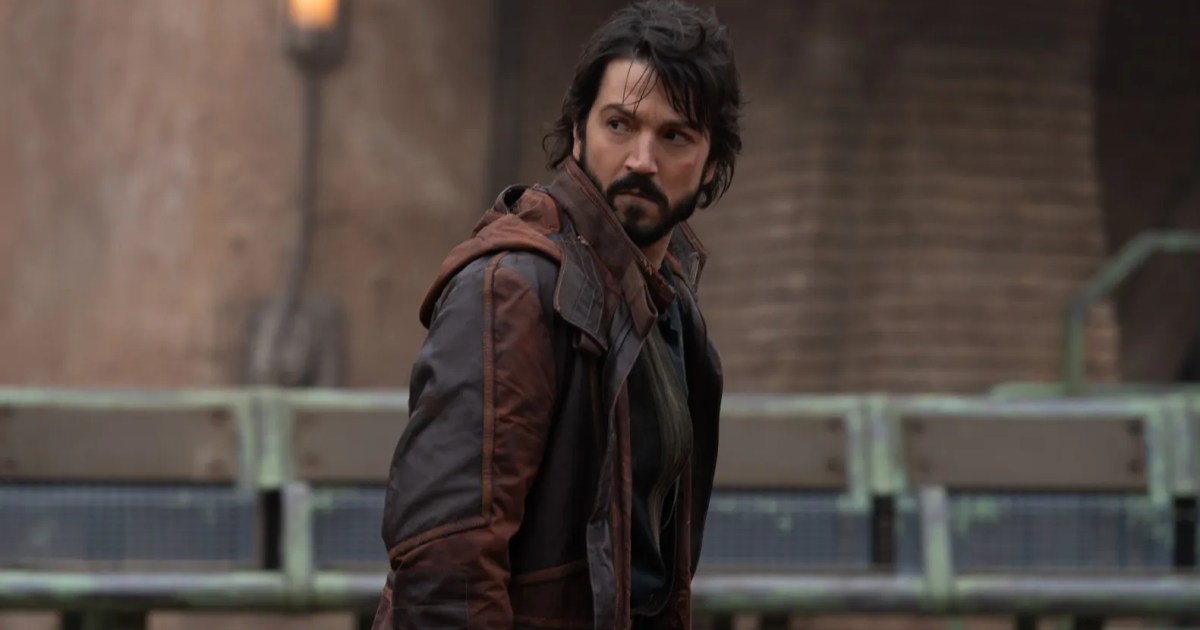On April 22, Andor, the greatest critical hit in the Star Wars family of Disney+ TV shows, will return for its long-delayed second and final season. The show, created by Tony Gilroy (Michael Clayton) has been rightly called “Star Wars for grown-ups” by its co-star Stellan Skarsgård, and its exploration of the dynamics of fascism, rebellion, and political radicalism made the first season compulsively watchable — never a lecture, but never simple-minded popcorn entertainment either.
To stick the landing on an all-too-brief run, Gilroy’s unexpected awards darling must focus on what makes it great – and not get drawn down the many garden paths that bedevil franchise entries like this one.
The faceless, arbitrary Empire
The superpower of Andor has been its ability to move fleetly through distinct but interrelated stories that never overstayed their welcome. The first season begins with the enlistment of Cassian Andor (Diego Luna), a nobody rogue from the outlying planet of Ferrix, into an audacious heist on a garrison controlled by the totalitarian Galactic Empire, some five years before the events of the original Star Wars trilogy. But the strongest stretch of the season is disconnected from that first adventure and covers the three episodes written by House of Cards creator Beau Willimon.
The genius move of these episodes is that Cassian manages to get away from the successful heist scot-free and then is almost immediately falsely arrested for a different crime of which he is totally innocent. His subsequent imprisonment in a floating labor camp on Narkina 5 lays the groundwork for the series’ most clearly defined world-building — an intricate but cleanly delineated prison system that lays bare the Empire’s cruelty. The hard-left turn of Cassian’s arrest on baseless charges, rather than being caught for his actual crimes against the Empire, emphasizes the arbitrariness of fascist power. That’s the Empire we need more of in season 2 — not the vengeful, effective, familiar villains of the original Star Wars series, but the faceless, uncaring, inexact iron boot of power we recognize from real life.
New pairings
I’m looking forward to what promises to be a romantic reunion for Cassian and his old flame Bix Caleen (Adria Arjona, one of the most exciting young actresses in Hollywood), who were separated for most of the first season. But perhaps more interesting — and certainly more disturbing — is the quasi-sexual rapport built over the back half of season 1 between the series’ two main villains, Imperial security supervisor Dedra Meero (Denise Gough) and the lowly Imperial functionary Syril Karn (Kyle Soller). Karn was once Deputy Inspector for the Pre-Mor Authority, a corporate wing of the Empire, but was disgraced and discharged for overzealousness in pursuing Cassian. Meero, over the course of season 1, rises through the ranks of the Imperial Security Bureau (ISB) through her dogged pursuit of that same budding rebel. In the season 1 finale, Rix Road, they are unexpectedly thrown together in a skin-crawlingly intimate sequence that suggests their mutual target may not be all they’ll share.
Meero wields all the real power, but Karn is Cassian’s twin – a nobody radicalized by the harsh realities of life in a brutal galaxy – and thus more accurately pinpointed as the titular Andor’s opposite number. Season 1 did a brilliant job of building unlikely sympathy for Meero, who navigates a largely male ISB with sheer professionalism, and Karn, who, despite his oily unctuousness, is a true believer in the Empire’s cause. One of Andor’s most impactful tricks is making its villains, for all their loathsome ideology, “honorable” as far as the plain dealing of their strategy, and its heroes, like Skarsgård’s rebel leader Luthen Rael, willing to do horrible things in the service of a just and justified rebellion. With any luck, season 2 will double the impact of this tack by placing Karn and Meero side by side.
Wrapping up loose ends

The major unsolved riddle of season 2 was the whereabouts of Cassian’s sister, Kerri (played as a child by Belle Swarc). We’re repeatedly assured that Kerri must have died in the Imperial mining disaster that destroyed Cassian’s home planet of Kenari. Given that season 1 begins with Cassian still determinedly looking for her (a search he soon abandons to continually save his own skin over the twelve episodes that follow), I expect her to pop up somewhere. (Or be identified as someone we’ve already met, given the show’s tendency to reveal that its characters are related in unexpected ways.)
Perhaps, in reckoning with the fate of Kenari, Gilroy and his fellow writers can wrestle with the effective kidnapping of young Cassian by off-world scavenger Maarva (Fiona Shaw), who later becomes his loving mother figure. It’s presented as pure altruism in the first season, but plays as uncomfortably colonialist.
Avoiding franchise pitfalls

I’m intrigued but concerned that in season 2, Ben Mendelsohn will be reprising his role as Orson Krennic, Director of Advanced Weapons Research for the Empire. Krennic first arrived in Rogue One: A Star Wars Story, with Luna’s Cassian also making his first on-screen appearance. (Alan Tudyk, Hollywood’s most ubiquitous voice actor, will also be appearing as the droid K-2SO, also from Rogue One.) Mendelsohn is a superb actor whose air of menace is earthy rather than slick, leavened by a sense of reality that recalls the best of Jeremy Irons.
But Andor is not just a prequel to Rogue One: it’s its own story, one that fits more comfortably on its own than when the viewer tries to crowbar it into Star Wars’ self-contradictory canon. Krennic’s role as designer of the Death Star is frightening, no doubt, within the context of foreshadowing. But with any luck, Andor season 2 will make him an impactful villain for what we’ll actually see him do this season — not what we can expect him to do in another franchise entry.
Andor season 2 premieres on Disney+ on April 22 with three new episodes.
Read the full article here
















